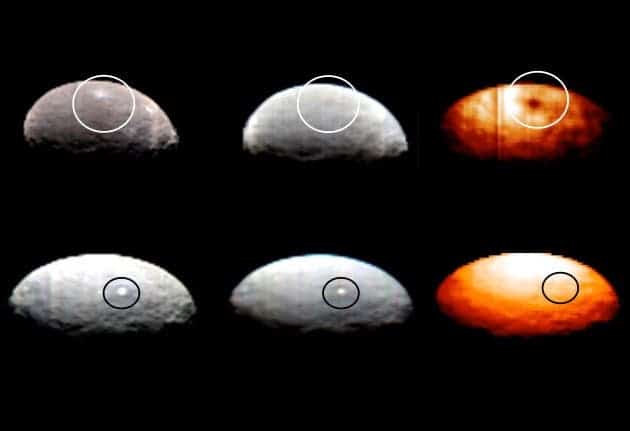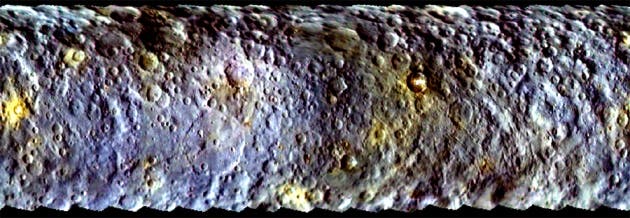NASA’s Dawn spacecraft already has an impressive resume – it’s traveled to the asteroid belt and managed to start orbiting the dwarf planet Ceres, even though Ceres measures only 950 kilometers (590 miles) in diameter and has a very small gravitational field. But it’s not stopping just yet – after previously revealing a number of black and white pictures, Dawn has now provided a color photograph, but here’s the thing – it poses more questions than it answers.

Infrared images suggest that Spot 1 (top row), an area on Ceres, is made of ice. But the pair of bright gleams known as Spot 5 were invisible to an infrared camera (bottom right). Image credits: NASA/JPL-Caltech/UCLA/ASI/INAF
Ceres is the largest object in the asteroid belt between Mars and Jupiter. It comprises of rock and ice, and despite its small size (it’s about as big as Argentina), it is considered to be a dwarf planet (though some astronomers consider it an asteroid). Subsequently, it’s drawn quite a lot of scientific interest, and Hubble first looked at it a few years ago; but it wasn’t until the Dawn spacecraft actually started orbiting it that we got a really good look at it.
“This is the first idea of what the surface looks like,” said Martin Hoffmann, a Dawn scientist from the Max Planck Institute for Solar System Research in Göttingen, Germany.
Dawn took several tantalizing pictures of bright spots on Ceres, which might be the result of some active geology – something extremely exciting. In total, astronomers noticed 5 particular spots which they are trying to figure out.

The surface of the dwarf planet Ceres (shown here) has fewer large craters than researchers expected. Image credits: NASA/JPL-Caltech/UCLA/MPS/DLR/IDA.
But could a celestial body so small actually have proper geology? Some scientists have speculated that one of the spots could be linked to an icy plume – a feature of so-called ‘cryovolcanoes’, volcanoes that spew ice and water instead of magma and ash. Finding such a small and yet active body is intriguing to say the least, but for now, Ceres is still keeping its secrets. We don’t know for sure what those spots are, how they were created, whether or not there is active geology or even whether frozen volcanoes actually exist.
“Dawn took its most recent set of images on 10 April, but only a small fraction of Ceres’s surface was illuminated at the time and mission scientists have not yet released them. The spacecraft will begin detailed science investigations on 23 April, after it settles into permanent orbit around Ceres,” Nature writes.
Dawn will near Ceres even more and take even more revealing, hopefully helping unravel the secrets that Ceres is hiding. The fact that we can get up-close and personal with something that’s so small and 400 million km away is absolutely mind blowing to me









